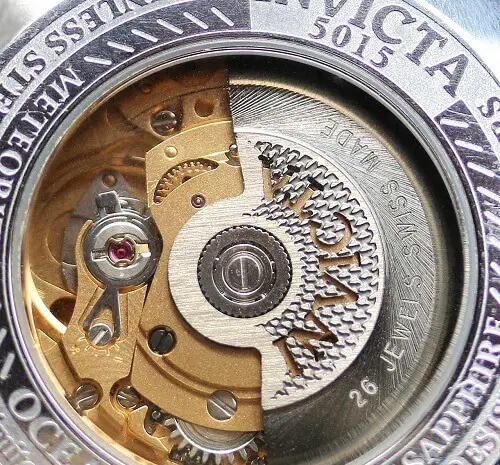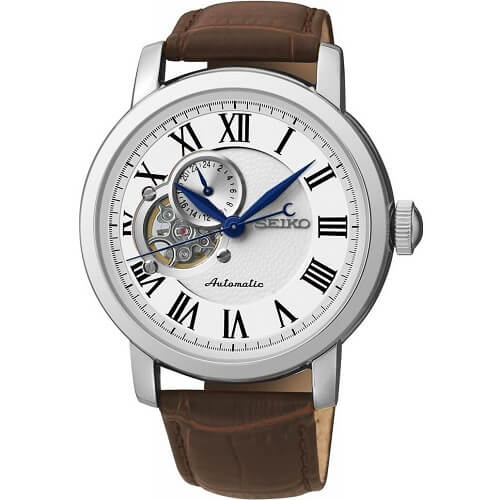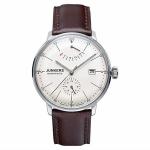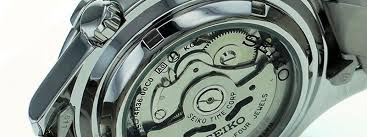A General Rundown before the Main Differences.
Today we’re going to be comparing the Japanese Automatic movement vs Swiss automatic movement. We’ll look at the benefits and disadvantages of each type of movement.
If we compare the complex manufacturing design of an automatic watch to that of a human purely on a comparative basis, we can easily come to the conclusion of the fact that the watch movement which controls the complete functioning of the automatic watch is akin to that of a human brain and heart in terms of the responsibility which these organs hold.
Simply, watches are simply unable to properly work without a proper movement mechanic.
The movement of a watch can be either mechanical, electronic or even a hybrid mechanical-electronic movement.
But if we go back to the era where the pioneering of wrist-watches was at its peak, the main movement used by watch companies was the mechanical movement with the advantage that if parts become faulty, they could be easily replaced with spare parts and start functioning normally right after.
However, as the development of watch movement progressed, automatic watch companies quickly switched over to electronic movements following the market trend.
But the trend quickly came back to the classy mechanical watch movements, with the introduction of standard watch movements patented by special and huge companies in the watch-making industry.
Now, most of the watch companies can be seen using these standardized watch movements instead of making their own, part of it because these watch movements are just that good each in their own ways.
The two standardized watch movements are;
- Japanese Automatic Movement
- Swiss Automatic Movement
These movements are so popular that if a good and pricy watch is opened up and given a critical and keen look, it will be employing either the Japanese or Swiss Automatic movement depending on the regional origins of the company.
Both of these movements are quite similar in a general overview but when considering every little detail when buying a watch, even these similar movements can end up showing differences with each being minute but impactful.
Swiss Automatic Movement
When talking about the Swiss Automatic Movement, we must first discuss the mark of identification to tell them apart from Japanese Automatic Movement.
Taking the example of some big Swiss companies, we have the largest Swiss company ETA, followed by other big names in the watch industry, Rotund, and ISA. All of these companies have their signature identification markings at the back of the watch or differentiated by the marks of the Watch Movement Company, in our case, Swiss Made.
Generally, the Swiss Automatic Movement consists of 3 letters, C.T.A. These letters are then followed by a unique number combination which serves the purpose of a reference number.
In other scenarios, there is a glassy red dot at the point of the pivot from where the wheel of the back of the watch goes through termed “The Level”.
In a watch, the second’s hand or the calendar window and the thickness of the dial all play a role in the working of the watch movement and even change the watch movement depending on these three aspects in a watch.
We will get to the actual and technical details between the Swiss and Japanese Automatic movements after giving a brief overview of the Japanese Automatic movement.
Japanese Automatic Movement
Unlike the Swiss Automatic Movement, this movement, invented by the Japanese Companies including Seiko and Casio (One of the largest watch companies in the world) has further classifications to the widely acclaimed Japanese automatic movement, the classifications being;
- Hattori Movement
- Miyota Movement
Hattori Movement is quite similar to the Miyota movement in many aspects but what puts the two apart from each other is that Hattori movement is interchangeable making it the reason Seiko prefers the Hattori Movement in their Japanese wrist watches.
Miyota Movement, on the other hand, has many technical differences from the Hattori Movement. Citizen prefers the Miyota 8215 Movement which consists of;
- Three Jeweled Hands paired with the date movement
- A Unidirectional Winding System
- An Accuracy of -20 to +40 seconds a day.
- A minimum power reserve of 40 hours.
- Sects at Six-Half Cycles per Second.
Apart from the two big Titans, Seiko, and Citizen, most of the Asian watch companies can be seen to either using one of these two movements.
Identification of the Japanese automatic movements in the wrist-watches, most of the times, is on the back or at the bottom of the dial. They can also be identified from the movement specified by the manufacturer. For example, Japanese Movements used by Citizen can be referred by them in their many models as, VX42, V810, etc.
Now, on to the main differences and similarities between the two;
Similarities in Swiss and Japanese Automatic Movement
- The Swiss and Japanese Automatic Movement are both above average than the traditional standards of 2.5HZ (18000BPH)
- The Swiss and Japanese Automatic Movement both use Synthetic Rubies in their movement. The jewels used in both of the Movements serve to reduce the wear and tear of the moving parts.
- The Swiss and Japanese Automatic movements are both better than other movements when taking into account the jewel number. Both the Swiss and Japanese Movements are above 17.
- Both the Swiss and Japanese Movements are automatic.
- Both the Swiss and Japanese Movements offer durability in terms of shock resistance.
Differences between the Swiss and Japanese Automatic Movement
- Swiss movements are generally more overpriced compared to the Japanese movements. A basic watch that is run by a Swiss Automatic movement can range up to 200£ and onwards while a Japanese Automatic Movement watch can be purchased for half the price.
- The Japanese Miyota is available with 21 Jewel movement and beats at 21600 Beats per Hour, in seconds, Six Beats Per Second. On the other hand, The Swiss ETA has a 25 jewel movement with 28800 Beats per Hour and in seconds, 8 Beats Per Second.
- When inspecting the movements of the two types through an open-heart skeleton watch, there will be a noticeable difference between the Swiss and Japanese movement in the sense that the Swiss ETA has a high-polish mechanic and gold plating while the Japanese Movements, Miyota and Hattori lack the gold plating and polished mechanic.
- As touched on before, The Swiss ETA has 25 jewels while the Japanese Miyota has only 21 jewels.
- The power reserve of an Automatic Watch, for which it can keep ticking on a full wind, is different for both the Japanese and Swiss Movements. The Swiss ETA comes with a reserve of 40 hours while the Japanese Miyota comes with a 45-hour reserve.
- The Swiss Automatic movement requires fewer winds per day to keep going compared to the Japanese Automatic Movement because of the Swiss Movement’s refrain from the use of ball bearings in their rotor allowing for a much more efficient winding of the watch.
- On the aspect of shock resistance, the Swiss Automatic movement uses a feature called Incabloc Shock Protection System. What this allows is the floating of the jewels when the watch is bumped or dropped. In Japanese Automatic movement, they have a variant of this feature called the Parashock.
- The Swiss Automatic movement does not stop momentarily at times due to wrist movements. The Japanese Automatic Movement, however, does stop for moments due to their drives, for example, Miyota in 8125.
While the differences and similarities may overlap and seem dismissible, when critically considered to tailor your choice for the best watch according to your budget, each difference can be significant in molding your decision.
Both the Swiss and Japanese Movements are unique and amazing in their own way but the Swiss Automatic movement is a tad bit pricier than the Japanese Automatic Movement so that is an aspect to keep in mind when choosing a watch.
Conclusion
In Short, The Swiss Automatic movement is generally used by Swiss-Made watches and utilized inexpensive timepieces due to their pricey nature. But the price is not unjustified, the top-notch working is worth the money if you are an eccentric watch collector or choose the Swiss watches to represent your taste and personality.
The Japanese Automatic Movement, on the Other hand, is up to the level of the Swiss Automatic movement with a bit of difference here and there but the quality is undoubtedly top-tier because the Japanese Watch Titans, Citizen, and Seiko, both use the Japanese Movement. The difference from the Swiss Movement is rectified by the humbleness in its price tag.
Both these movements are amazing and both provide absolutely amazing value for their price tags.
I hope that today’s article has helped you to gain an insight into what the Swiss and Japanese Automatic movements have to offer and that this article has helped you in choosing the right watch for yourself.
As always, leave a comment below about today’s article and let me know if you own a Swiss Automatic Movement or a Japanese Automatic watch and which one is the better contender and which one comes out on top in your opinion.




